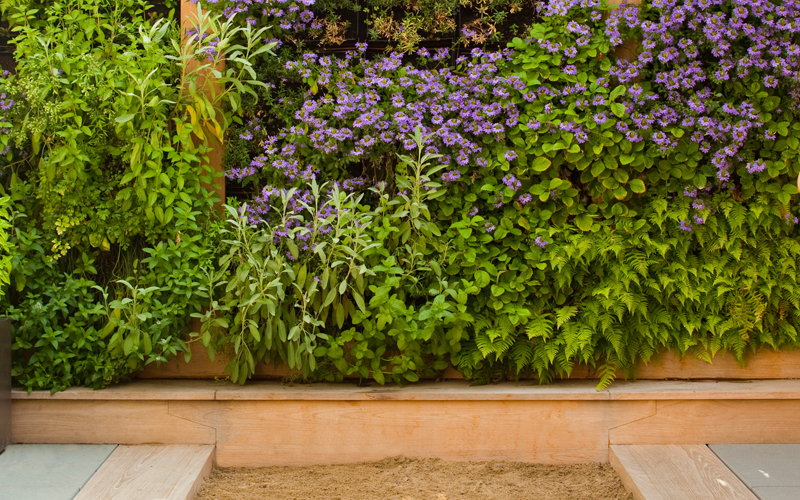Professional Practice
Increasing Energy Efficiency: Residential Green Walls
 A green wall with lush plantings and edibles sits above a children’s sandbox. ASLA 2011 Professional Residential Design Honor Award. Carnegie Hill House, Charlottesville, Virginia / Nelson Byrd Woltz Landscape Architects.
A green wall with lush plantings and edibles sits above a children’s sandbox. ASLA 2011 Professional Residential Design Honor Award. Carnegie Hill House, Charlottesville, Virginia / Nelson Byrd Woltz Landscape Architects.Like green roofs, green walls are vegetated walls that can be used indoors or outdoors. Green walls, also called vertical gardens, can increase energy efficiency, reduce indoor and outdoor temperatures, and improve air quality.
There are different types of green walls. Green facades are systems that support climbing vines or cascading ground covers and include a soil bed at the bed of the structure. Living walls, by contrast, are pre-vegetated panels and can support a greater variety and density of plants than green facades. Either can be free standing or attached to existing buildings. Retaining living walls are slope-stabilizing structures that contain vegetation.
Green walls can be designed for a variety of plant types, including herbs or succulents, and can be placed in either sun or shade. Edible herb or vegetable walls provide food sources. However, climate and humidity should be considered when installing green walls.
Green walls provide similar benefits to green roofs, but also include:
- Cost-efficiency: Through shading, green walls can lower temperatures in summer and reduce energy costs by 23 percent.
- Reduced air temperatures: Temperatures behind green walls can be reduced by as much as 10 degree Celsius. Green walls also reduce temperature fluctuation at the wall’s surface, which can damage a building’s façade overtime.
- Reduced Noise Pollution: Green walls can help reduce sound reflection
- Improve Indoor Air Quality: Green walls can filter airborne pollutants
Sources: About Green Walls, Green Roofs for Healthy Cities; “Living Walls: A Way to Green the Environment” Susan Loh, Australian Council of Built Environment Design Professionals, August 2008
Organizations
Centre for Architectural Ecology, British Columbia Institute of Technology
Vertical Farm
Association for Vertical Farming
Green Roofs for Healthy Cities
Resources
About Green Walls, Green Roofs for Healthy Cities
Introduction to Green Walls Technology, Benefits & Design, Greenroof for Healthy Cities, September 2008
Six Things You need to know about Green Walls, Randy Sharp, Building Design and Construction Network, 2007
Living Architecture Monitor
Trench & Vertical Tomato Planting Techniques, National Gardening Association
Research
"Planting Green Roofs and Living Walls," Nigel Dunnett & Noel Kingsbury, Timber Press, 2008
"The Vertical Garden: From Nature to the City," Patrick Blanc, W.W. Norton & Co., 2008
“Grow a Living Wall: Create Vertical Gardens with Purpose,” Shawna Coronado, Cool Springs Press, 2015
“Armitage’s Vines and Climbers: A Gardener’s Guide to the Best Vertical Plants,” Allan M. Armitage, Timber Press, 2011
Government Resources
Vertical Garden Grant Initiative, Anton Sinkewich, Central Houston, 2008
Vertical Greenery Incentive Scheme, Singapore, National Parks Board
Projects
Carnegie Hill House, New York City
Nelson Byrd Woltz Landscape Architects
Horizon Residence, Venice, California
Marmol Radziner and Associates, Los Angeles, Calfornia
Vertical Garden, Los Angeles, California
Mia Lehrer & Associates
Quaker Smith Point Residence, Burlington, Vermont
H. Keith Wagner Partnership